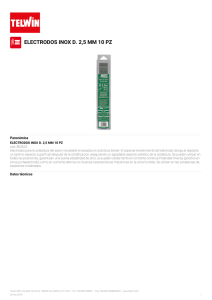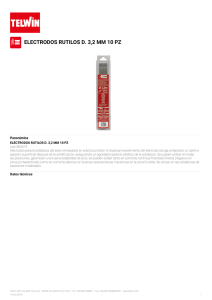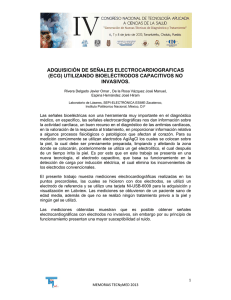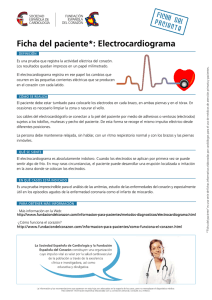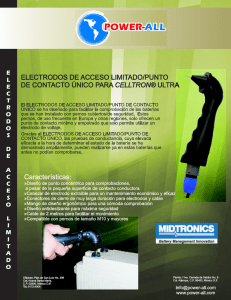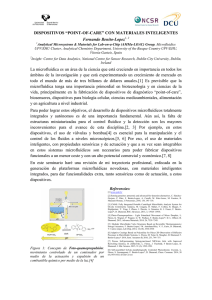ELECTRODOS FUNCIONALIZADOS CON REDES DE
Anuncio
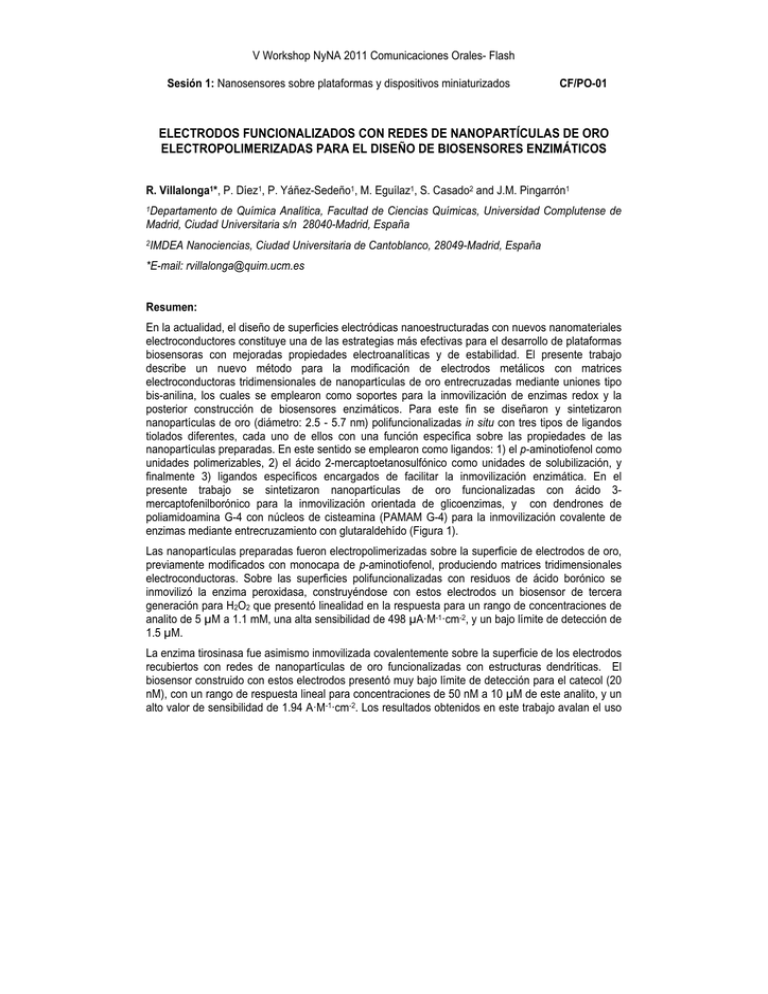
V Workshop NyNA 2011 Comunicaciones Orales- Flash Sesión 1: Nanosensores sobre plataformas y dispositivos miniaturizados CF/PO-01 ELECTRODOS FUNCIONALIZADOS CON REDES DE NANOPARTÍCULAS DE ORO ELECTROPOLIMERIZADAS PARA EL DISEÑO DE BIOSENSORES ENZIMÁTICOS R. Villalonga1*, P. Díez1, P. Yáñez-Sedeño1, M. Eguílaz1, S. Casado2 and J.M. Pingarrón1 1Departamento de Química Analítica, Facultad de Ciencias Químicas, Universidad Complutense de Madrid, Ciudad Universitaria s/n 28040-Madrid, España 2IMDEA Nanociencias, Ciudad Universitaria de Cantoblanco, 28049-Madrid, España *E-mail: [email protected] Resumen: En la actualidad, el diseño de superficies electródicas nanoestructuradas con nuevos nanomateriales electroconductores constituye una de las estrategias más efectivas para el desarrollo de plataformas biosensoras con mejoradas propiedades electroanalíticas y de estabilidad. El presente trabajo describe un nuevo método para la modificación de electrodos metálicos con matrices electroconductoras tridimensionales de nanopartículas de oro entrecruzadas mediante uniones tipo bis-anilina, los cuales se emplearon como soportes para la inmovilización de enzimas redox y la posterior construcción de biosensores enzimáticos. Para este fin se diseñaron y sintetizaron nanopartículas de oro (diámetro: 2.5 - 5.7 nm) polifuncionalizadas in situ con tres tipos de ligandos tiolados diferentes, cada uno de ellos con una función específica sobre las propiedades de las nanopartículas preparadas. En este sentido se emplearon como ligandos: 1) el p-aminotiofenol como unidades polimerizables, 2) el ácido 2-mercaptoetanosulfónico como unidades de solubilización, y finalmente 3) ligandos específicos encargados de facilitar la inmovilización enzimática. En el presente trabajo se sintetizaron nanopartículas de oro funcionalizadas con ácido 3mercaptofenilborónico para la inmovilización orientada de glicoenzimas, y con dendrones de poliamidoamina G-4 con núcleos de cisteamina (PAMAM G-4) para la inmovilización covalente de enzimas mediante entrecruzamiento con glutaraldehído (Figura 1). Las nanopartículas preparadas fueron electropolimerizadas sobre la superficie de electrodos de oro, previamente modificados con monocapa de p-aminotiofenol, produciendo matrices tridimensionales electroconductoras. Sobre las superficies polifuncionalizadas con residuos de ácido borónico se inmovilizó la enzima peroxidasa, construyéndose con estos electrodos un biosensor de tercera generación para H2O2 que presentó linealidad en la respuesta para un rango de concentraciones de analito de 5 µM a 1.1 mM, una alta sensibilidad de 498 µA·M-1·cm-2, y un bajo límite de detección de 1.5 µM. La enzima tirosinasa fue asimismo inmovilizada covalentemente sobre la superficie de los electrodos recubiertos con redes de nanopartículas de oro funcionalizadas con estructuras dendríticas. El biosensor construido con estos electrodos presentó muy bajo límite de detección para el catecol (20 nM), con un rango de respuesta lineal para concentraciones de 50 nM a 10 µM de este analito, y un alto valor de sensibilidad de 1.94 A·M-1·cm-2. Los resultados obtenidos en este trabajo avalan el uso V Workshop NyNA 2011 Comunicaciones Orales- Flash Sesión 1: Nanosensores sobre plataformas y dispositivos miniaturizados bioelectroanalítico de electropolimerizadas. electrodos nanoestructurados con matrices CF/PO-01 de nanopartículas Figura 1: Preparación de los electrodos nanoestructurados con redes de nanopartículas de oro para la detección de H2O2 (A) y catecol (B). V Workshop NyNA 2011 Comunicaciones Orales- Flash Sesión 1: Nanosensores sobre plataformas y dispositivos miniaturizados CF/PO-02 ESTUDIO COMPARATIVO DE DISTINTOS TRANSDUCTORES NANOESTRUCTURADOS SOBRE ELECTRODOS SERIGRAFIADOS E. Costa Rama, M. B. González García y A. Costa García* Departamento de Química Física y Analítica, Facultad de Química, Universidad de Oviedo, Av. Julián Clavería 8, 33006 Oviedo, España *E-mail: [email protected] Resumen: Los electrodos serigrafiados de carbono o Screen-Printed Carbon Electrodes (SPCEs) suscitan un gran interés como transductores para la construcción de sensores electroquímicos debido a sus importantes ventajas como son bajo coste, pequeñas dimensiones, versatilidad, además de buenas características electroanalíticas. Para mejorar las propiedades analíticas de estos electrodos se pueden emplear nanomateriales de carbono como nanotubos de carbono (CNTs) y grafeno. Los CNTs tienen una capacidad extraordinaria para acelerar la cinética de transferencia electrónica; además mejoran la reversibilidad de las reacciones y reducen los sobrepotenciales. Los grupos funcionales oxigenados situados en los extremos de los nanotubos favorecen aún más estas propiedades electroquímicas. Los electrodos basados en grafeno muestran un rendimiento superior en términos de actividad electrocatalítica y conductividad a escala macroscópica que los basados en CNTs1. En comparación con los CNTs, el grafeno posee ventajas como menor coste y mayor área superficial. Además, la estructura electrónica y la superficie fisicoquímica del grafeno benefician la transferencia electrónica1. Por otro lado, las nanopartículas también pueden aportan ventajas a los electrodos en el análisis electroquímico como son la mejora en el transporte de carga y el aumento del área superficial. Sin duda, una de las nuevas tendencias es la utilización de materiales híbridos como son los nanomateriales de carbono junto con las nanopartículas de oro (AuNP) con el fin de desarrollar transductores que combinen las ventajas de una y otra nanoestructura. En este trabajo se desarrollan diferentes transductores basados en SPCEs modificados con óxido de grafeno (GO) y también modificados con materiales híbridos formados por GO y AuNP. Estos transductores se comparan con los obtenidos al modificar SPCEs con nanotubos de carbono multicapa (MWCNTs) y con materiales híbridos basados en MWCNTs y AuNP. Sobre estos transductores se estudian procesos controlados por difusión utilizando cuatro especies electroactivas: p-aminofenol, ferricianuro, hidroquinona y dopamina. Se comparan diferentes propiedades de los transductores obtenidos: área electródica, sensibilidad, capacidad de la doble capa y constante de velocidad de transferencia electrónica. 1 Shao, Y. et al. Electroanalysis, 22 (2010) 1027 V Workshop NyNA 2011 Comunicaciones Orales- Flash Sesión 1: Nanosensores sobre plataformas y dispositivos miniaturizados CF/PO-02 Para complementar el estudio se caracterizaron las superficies obtenidas sobre los SPCEs en cada caso por microscopia electrónica de barrido (SEM). Agradecimientos: Estefanía Costa Rama agradece la beca predoctoral UNOV-10-BECDOC-S concedida por la Universidad de Oviedo-Banco de Santander V Workshop NyNA 2011 Comunicaciones Orales- Flash Sesión 1: Nanosensores sobre plataformas y dispositivos miniaturizados CF/PO-03 “ANALYTICAL PERFORMANCE OF ELECTROCHEMICAL DETECTORS BASED ON SWCNTS ON MICROFLUIDICS” D. Vilela1, Javier Hernandez2, Alejandro Ansón2, M. Teresa Martínez2, M.C. González1 and A. Escarpa1* 1Department of Analytical Chemistry and Chem. Ing. Faculty of Chemistry. Universidad de Alcalá,Ctra. Madrid-Barcelona. KM. 33,600 28871 Alcalá de Henares. Madrid. Spain. 2Instituto de Carboquímica ICB-CSIC, Miguel Luesma 4, 50018 Zaragoza, Spain E-mail: [email protected] Abstract: Electrochemical detection (ED) is a very well-suited detection principle for microfluidic chips because of its inherent features of miniaturization without the loss of performance and its compatibility with advanced micromachining. High sensitivity and responses, not dependent on the optical path length or sample turbidity, are additionally very attractive features. Moreover, the rapid progress in nanotechnology has opened a wide range of horizons for its applications in electrochemistry. In this way, carbon nanotubes-based electrodes (CNTs) offer many advantages over conventional ones, such as greater sensitivity, and diminishing of detection potentials via electrocatalytic effect1 To exploit the inherent advantages derived from CNTs, their full-characterization prior to be used with analytical purposes is of paramount importance. Several aspects must be studied, such as the route of the synthesis, dispersion performance, purity obtained during synthesis, and the oxidation processed performed on. The aim of this work has been the evaluation of different single walled carbon nanotubes (SWCNTs) as electrochemical detectors in microfluidic systems. Screen-printed electrodes were modified with the different SWCNNTs in order to build the electrochemical detectors. The influence of dispersant agents (pluronic, SDBS and DMF) as well as the physical and chemical treatment (NIR index, oxidation processes, and dialysis)2 were systematically studied. Also, hybrid materials based on SWCNTs-AuNPS have been explored. Acknowledgments: Financial support from the Spanish Ministry of Science and Innovation CTQ2008-06730-CO2-02/BQU and AVANSENS program from Community of Madrid (P2009/PPQ1642) are grateful acknowledged. 1 Lab Chip 9 (2009) 346-353 2 Langmuir, 2011,17, 7192-7198 V Workshop NyNA 2011 Comunicaciones Orales- Flash Sesión 1: Nanosensores sobre plataformas y dispositivos miniaturizados CF/PO-04 MODULAR MICROFLUIDIC SYSTEM FOR THE SYNTHESIS AND THERMAL CONTROL OF REACTIONS DEVELOPED AT HIGH TEMPERATURE. APPLICATION TO THE SYNTHESIS OF HIGH EFFICIENT CdSe QUANTUM DOTS IN ORGANIC MEDIUM Sara Gómez de Pedro, Mar Puyol and Julián Alonso Sensors and Biosensors Group, Universitat Autònoma de Barcelona, Bellaterra, Barcelona, Spain E-mail: [email protected] Abstract: Inorganic nanocrystalline semiconductors (quantum dots) are widely used as tuneable emitters for many applications such as light-emitting diodes, computing and sensors due to their unique photophysical properties4. Cadmium selenide (CdSe) quantum dots display one of the most valuated optical properties due to quantum-size effects: its tunable size-dependent photoluminescence across the visible spectrum. This property confers to the CdSe nanocrystals the possibility of replacing fluorophores as labels since they are photostables, show sharp emission spectra along the whole visible region and present large decay lifetimes. However, such properties are closely to the synthetic process performed. Therefore, the reaction conditions must be extremely controlled. Conventional synthetic methods of CdSe nanocrystals usually are based on the thermal decomposition of cadmium and selenium precursors in organic solvents. These syntheses entail the use of refluxes and oil baths, where not only is difficult to control the concentration fluctuations, but also the temperature5. This issue can be overcome when microreactors are applied since most of the reaction parameters can be automatically controlled by means of computer assisted systems. The use of microfluidic devices allows preparing high quality nanoparticles with key advantages such as fast thermal- and mass-transfer rates and continuous products production. As a matter of fact, microfluidic approaches have been successfully applied to the synthesis of numerous metal, metal-oxide and semiconductor nanoparticles, including CdSe. Materials such as glass, silicon and polymers have been used in the fabrication of microfluidic devices. However, most of the employed manufacturing methods not only require a post fabrication sealing of the microchannels (which produces leaks at the joins) but also exhibit slow prototyping procedures and poor chemical and thermal stability6. Our research group proposes the use of ceramic tapes based on the Low-Temperature Co-fired Ceramics (LTCC) technology. This material allows a multilayer approach, being feasible the design and fabrication of 3D structures, where mechanic, electronic and fluidic components (such as static or X. Michalet, et. al., Science, 2005, 307, 538. . A. Peng, X. Peng, J. Am. Chem. Soc., 2001,123, 183-184. 6 D.M Leatzow, J.M. Dodson, J.P. Golden, F.S. Ligler, Biosens. Bioelectron., 2002, 17, 105. 4 5 V Workshop NyNA 2011 Comunicaciones Orales- Flash Sesión 1: Nanosensores sobre plataformas y dispositivos miniaturizados CF/PO-04 dynamic mixers and resistors/thermistors couples) can be integrated in a single device. Moreover, post fabrication steps are avoided and the technology does not require the use of special facilities such as clean rooms. This permits a rapid prototyping, reducing significantly the costs and the production time7. In this work, a ceramic microreactor for the synthesis of CdSe quantum dots at high temperatures is presented. The device is based in two modules, one for the temperature control and other for the microfluidic platform (figure 1). Since temperature can be regulated as required, using a specifically designed electronic system, CdSe quantum dots emitting/absorbing at different wavelengths can be easily obtained. The microsystem developed is successfully applied to the continuous, automated and controlled synthesis of different-sized nanocrystals. The synthesized quantum dots exhibit narrow absorption and fluorescence emission bands, entailing a uniform size distribution of the colloidal. The quality observed from the obtained spectra, demonstrate the reliability of the proposed microsystem to be applied to reactions strongly dependent on temperature. Figure 1: A: Top view of the ceramic microfluidic device. B: Scheme of the thermal platform showing the embedded heater. C: Scheme of the microfluidic platform showing the inlets/outlet and an amplification of a microreactor region. 7 S. Gómez-de Pedro, M. Puyol, J. Alonso, Nanotechnology, 2010, 21, 415603. V Workshop NyNA 2011 Comunicaciones Orales- Flash Sesión 1: Nanosensores sobre plataformas y dispositivos miniaturizados CF/PO-05 FAST AND RELIABLE URINE ANALYSIS USING PORTABLE PLATFORMS BASED ON LAB-ON-A-CHIP TECHNOLOGIES Mario Castaño-Álvarez, Ana Fernández-la-Villa, Diego F. Pozo-Ayuso MicruX Technologies, Severo Ochoa Bldg. Julián Clavería s/n, Floor -1 Room 4&6, 33006 Oviedo (Asturias) Spain E-mail: [email protected], web: www.micruxfluidic.com Abstract: Lab-on-a-Chip (LOC) technologies has become a powerful analytical tool offering high speed, great versatility, high throughput, low cost, performance of parallel assays and negligible consumption of reagents/sample and waste generation8. Microchips capillary electrophoresis (MCE) can be considered the first stage to get a “true” Lab-on-aChip (LOC) in which would be integrated all the steps of an analytical process. Thus, these devices in combination with electrochemical detection have been used in the determination of uric acid and related compounds in urine samples. Uric acid (UA) and its salts are end products of the purine metabolism. With progressive renal insufficiency, retention of urea, creatinine and uric acid takes place in blood. Elevate uric acid level may be indicative of renal insufficiency and is commonly associated with gout9. Conventional methods for the measurement of uric acid are based on enzymatic reactions and colorimetric techniques. However, this methodology is temperature-dependent, expensive and requires labile reagents. An additional obstacle in monitoring UA levels is the interference from other compounds such as epinephrine, DOPA, ascorbic acid, acetaminophen, xanthine, theophylline or caffeine coming from endogenous or exogenous sources. A novel instrumentation (Figure 1) which combines in a compact and portable unit a high voltage power supply and a potentiostat has been specially developed for using microchip capillary electrophoresis with electrochemical detection10. The analysis system is completed with a reusable chip platform as easy-handle interface between the micro/nano- and macro-world (Figure 1). The system is controlled from a desktop or laptop PC by means of a user-friendly graphical interface designed for microchip electrophoresis. P.S. Dittrich, K. Tachikawa, A. Manz, Micro Total Analysis Systems. Latest advancements and trends, Anal. Chem. 2006, 78, 3887 – 3908. 9 A. Fernández-la-Villa, D. Pozo-Ayuso, M. Castaño-Álvarez, New analytical portable instrument for microchip electrophoresis with electrochemical detection, Electrophoresis 2010, 31, 2641 – 2649. 10 A. Schultz. Uric acid. A. Kaplan et al. Clin. Chem. The C.V. Mosby Co. St Louis. Toronto. Princeton 1984; 1261-1266 and 418. 8 V Workshop NyNA 2011 Comunicaciones Orales- Flash Sesión 1: Nanosensores sobre plataformas y dispositivos miniaturizados CF/PO-05 Figure 1: Portable analysis system for using microchips electrophoresis with amperometric detection This portable analysis system allows the separation, detection and quantification of uric acid and related compounds. Thus, a new analytical methodology have been developed for the separation of uric acid, acetaminophen, epinephrine, p-aminophenol and ascorbic acid in less than 60s (Figure 2A) using the portable system. 12 (A) APAP 1 nA AA EP UA 8 Current Current (nA) UA (B) pAP 10 6 (d) (c) (b) (a) 4 2 0 0 10 20 30 40 time (s) 50 60 70 80 0 10 20 30 40 time (s) 50 60 70 80 Figure 2: (A) Electropherogram for a mixture of epinephrine, p-aminophenol, acetaminophen, uric acid and ascorbic acid. (B) Electropherograms for a urine sample with successive additions of uric acid: (a) 0, (b) 100, (c) 200 and (d) 300 µM. This methodology and the portable system have been successfully tested for the determination of uric acid in the urine sample of healthy volunteers and gout-antecedent volunteers. The uric acid is directly detected without previous enzymatic based-reactions or other complex pretreatment. The urine sample is simply diluted in the buffer solution and injected directly in the microchips where the uric acid is separated and detected at platinum electrode of a SU8/pyrex microchip (Figure 2B). V Workshop NyNA 2011 Comunicaciones Orales- Flash Sesión 1: Nanosensores sobre plataformas y dispositivos miniaturizados CF/PO-05 The portable analysis system and the developed methodology can be also used in the determination of other biological samples (serum, plasma), pharmaceuticals etc. Currently, the new analytical system is being evaluated for using in clinical trials and it is provided as teaching kit for Universities and Research Centers. Acknowledgements: This work has been supported by the Spanish Ministry of Science and Innovation (MICINN - PTQ-09-01-00263, PTQ-09-01-00264 and PTQ-10-02730) and Centre for the Development of Industrial Technology (CDTI – NEOTEC IDI-20091097). V Workshop NyNA 2011 Comunicaciones- Pósters Sesión 1: Nanosensores sobre plataformas y dispositivos miniaturizados PO-31 NOVEL MINIATURIZED HIGH VOLTAGE POWER SUPPLY USEFUL FOR MULTIPLE ANALYTICAL APPLICATIONS Diego F. Pozo-Ayuso, Ana Fernández-la-Villa and Mario Castaño-Álvarez MicruX Technologies, Severo Ochoa Bldg. Julián Clavería s/n, Floor -1 Room 4&6, 33006 Oviedo (Asturias) Spain E-mail: [email protected], web: www.micruxfluidic.com Abstract: Miniaturization of analytical systems is of paramount importance in order to get new technologies which provide features such as high speed, great versatility, high throughput, low cost, performance of parallel assays and low consumption of reagents/sample and waste generation. In this way, the different parts of an analytical system have to be adequately adapted and miniaturized. Microfluidic systems such as microchips capillary electrophoresis (MCE) provide a first stage in the way of the complete miniaturization process. However, microfluidic devices performance requires an additional instrumentation to work with, mainly, a high voltage power supply (HVPS) for driving the fluids through microchannels, an acquisition data system for recording the analytical signals and an easy-handle interface. Nowadays, in most of the cases, this instrumentation is not in harmony with the features of microdevices, specially, relative to miniaturization and portability. Moreover, the new generation of analytical instrumentation has to be compatible with the resources that are currently in most of the research laboratories. Thus, it is possible to use these resources with new miniaturized instruments reducing cost. In this work, a novel low-cost instrument (Figure 1) has been specially developed for using in different applications and it is completely compatible with other analytical systems. The new instrument consists of a manual-control miniaturized high-voltage power supply (μHV) with a maximum output voltage of 2000V and reversible polarity. The miniaturized HVPS has dimensions of 140 x 100 x 40 mm (L x W x H) and weighs less than 1 Kg. The instrument is fed by a lithium-ion battery of 4800 mAh that is enough for a complete day working with the system. It also works connected to the electrical net. The use of a battery-powered system allows the performance of true in-situ analysis, whenever and wherever it is needed. The performance of the HVPS has been checked using microchips capillary electrophoresis with electrochemical detection (Figure 2A). Additionally, a microfluidic platform has been used in order to make easier the work with microchips (Figure 2B). The microfluidic platform acts as an easy-handle interface between the micro- and macro-world. It has been designed to use different kinds of single- and dual-channel microchips capillary electrophoresis with integrated electrodes. Besides, the holder incorporates standard fluidic ports in order to couple different fluidic parts (micropumps, valves…) as well as the electric connections for V Workshop NyNA 2011 Comunicaciones- Pósters Sesión 1: Nanosensores sobre plataformas y dispositivos miniaturizados PO-31 the HVPS and potentiostat (for amperometric measurements). The electrical connections consist of standard 2mm female-bananas, thus, most of the current analytical-equipment can be plugged in the holder. In conclusion, the authors present a complete and low-cost analytical system to start working with different microfluidic devices maintaining important features such as miniaturization and portability. Moreover, it can be coupled with other commercial systems as potentiostats, microchips capillary electrophoresis etc… present in many research laboratories. Acknowledgements:This work has been supported by the Spanish Ministry of Science and Innovation (MICINN - PTQ-09-01-00263, PTQ-09-01-00264 and PTQ-10-02730) and Centre for the Development of Industrial Technology (CDTI – NEOTEC IDI-20091097). Figure 1: Portable High Voltage Power Supply for driving fluids through microfluidic devices Figure 2: Platforms used in the evaluation of miniHVPS. (A) Microchip capillary electrophoresis. (B) Microfluidic interface. V Workshop NyNA 2011 Comunicaciones- Pósters Sesión 1: Nanosensores sobre plataformas y dispositivos miniaturizados PO-32 ESTRATEGIAS EN LA PREPARACIÓN DE ELECTRODO DE NANOTUBOS DE CARBONO. Álvaro Colina1, David Ibáñez1, Edna C. Romero1, Jesús Garoz1, Susana Palmero1, Aránzazu Heras1, Virginia Ruiz2,3, Jesús López- Palacios1 1.- Departamento de Química, Universidad de Burgos, Pza. Misael Bañuelos s/n, E-09001 Burgos, Spain. e-mail: [email protected]; Fax: +34 947 258831; Tel: +34 947 258817 2.- Departamento de Nuevos Materiales. CIDETEC-IK4 - Centro de Tecnologías Electroquímicas. Parque Tecnológico de San Sebastián. Paseo Miramón, 196 E-20009 Donostia - San Sebastián, Spain. 3.- Department of Applied Physics and Centre for New Materials, Aalto University, P.O. Box 15100, FI-00076 Aalto, Espoo, Finland Resumen: Los nanotubos de carbono (CNT) son uno de los nuevos materiales con mayores posibilidades en los próximos años. El avance en la síntesis de estos materiales ha sido extraordinario y actualmente es bastante sencillo encontrar nanotubos de carbono mono o multicapa con buenas características físico-químicas (nivel de pureza, longitud, tamaño, reproducibilidad etc). La inmovilización de los CNT como películas delgadas se ha llevado a cabo en diversas aplicaciones en áreas tales como la Biología y la Biomedicina, en catálisis, sensores químicos, transistores, capas conductoras transparentes, etc11. Uno de los principales factores que condiciona el tipo de películas de CNT es el modo en el que se obtienen éstas. Aunque ha habido un gran desarrollo en la modificación de electrodos con nanotubos de carbono y en la formación de películas conductoras de nanotubos, son pocos los estudios sistemáticos en el desarrollo de estos nuevos materiales como superficies electródicas. Así, es fundamental el uso de metodologías adecuadas de formación y transferencia de las películas a diversos sustratos dependiendo de su aplicación o estudio final. En el presente trabajo, se han aplicado metodologías de formación y caracterización de películas de nanotubos utilizando: • Técnicas de empaquetamiento basadas en la balanza de Langmuir, y posterior transferencia, por la técnica de Langmuir-Schaefer (LS), al sustrato deseado con el fin de modificar electrodos que posteriormente puedan ser utilizados como sensores. La gran ventaja de esta técnica es que normalmente la cantidad necesaria de nanotubos de carbono es muy pequeña. • Técnicas de formación de películas basadas en procesos de filtración, optimizando la relación conductividad/transparencia cuando el fin último de las mismas sea su uso como electrodos 11 Baughman, R.H., Zakhidov, A.A., De Heer, W.A. 2002 Science 297, 787-792 V Workshop NyNA 2011 Comunicaciones- Pósters Sesión 1: Nanosensores sobre plataformas y dispositivos miniaturizados PO-32 ópticamente transparentes sin ningún otro soporte conductor. Este tipo de electrodos son extremadamente útiles, por ejemplo, en técnicas espectroelectroquímicas. Los electrodos de nanotubos o modificados por nanotubos se han estudiado con técnicas electroquímicas12 y espectroelectroquímicas13 que proporcionan sustancial información sobre sus características y rendimiento. La figura 1 muestra una película de nanotubos de carbono transferida a un soporte transparente, así como las diferentes etapas en la construcción de un electrodo ópticamente transparente para su uso en espectroelectroquímica. Agradecimientos: Agradecemos la financiación de la Junta de Castilla y León (GR71, BU006A09, BU012A09) y Ministerio de Ciencia e Innovación (CTQ2010-17127). D.I. agradece su contrato de investigación a la Junta de Castilla y León. J.G. agradece la ayuda destinada a Jóvenes Excelentes de la Obra Social de Caja de Burgos, Banca Cívica. Figura 1. Etapas de la fabricación de un electrodo transparente de nanotubos de carbono. 12 13 Dumitrescu I., Unwin P.R., MacPherson J.V., 2009 Chemical Communications 45, 6886-6901. Kavan, L., Dunsch, L. 2011 ChemPhysChem 12, 47-55
